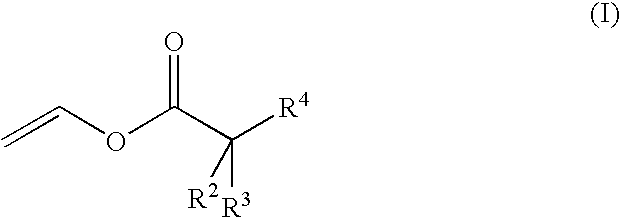Aqueous copolymer dispersions with reactive diluent
a copolymer and reactive diluent technology, applied in the field of aqueous copolymer dispersions, can solve the problems of unavoidable use of organic solvents, high apparatus and energy expenditure, and undesirable use of sizable amounts of organic solvents, and achieve the effects of reducing equipment and energy expenditure, reducing equipment and equipment costs, and increasing crosslinking density
- Summary
- Abstract
- Description
- Claims
- Application Information
AI Technical Summary
Benefits of technology
Problems solved by technology
Method used
Image
Examples
example 1
[0069] A 4-Liter, multi-necked flask equipped with stirrer mechanism was charged with 469 g of 1,6-hexanediol and 454 g of ε-caprolactone, plus 0.2 g of titanium tetraisopropoxide, and this initial charge was heated to 110° C. by means of an oil bath under a stream of inert gas (nitrogen). 401 g of dimethyl carbonate were added to the reaction mixture over 15 minutes by means of a pump, after which the mixture was held under reflux for a further 24 hours. Then a mixture of dimethyl carbonate and methanol was removed from the reaction mixture under atmospheric pressure via a distillation column, the oil bath temperature being raised continuously over 7 hours from 110° C. to 150° C. This was followed by a reduction in the oil bath temperature to 100° C. and in the pressure to 20 mbar (absolute), accompanied by removal of methanol and residual dimethyl carbonate. Subsequently the oil bath temperature was increased to 180° C. over 5 hours, and held at this temperature for 2 hours. The r...
example 2
[0070] Example 1 was repeated except that 861 g of 1,6-hexanediol and 0.2 g of ytterbium(III) acetylacetonate were introduced as the initial charge and 826 g of dimethyl carbonate were pumped in. The addition of 0.2 g of dibutyl phosphate, as in Example 1, was omitted. The resulting polycarbonate diol had a hydroxyl number of 109 mg KOH / g.
example 3
[0071] Example 1 was repeated except that 616 g of 1,6-hexanediol, 1408 g of 1,4-butanediol and 0.2 g of ytterbium(III) acetylacetonate were introduced as the initial charge and 2477 g of dimethyl carbonate were pumped in. The addition of 0.2 g of dibutyl phosphate, as in Example 1, was omitted. The resulting polycarbonate diol had a hydroxyl number of 113 g KOH / g.
PUM
| Property | Measurement | Unit |
|---|---|---|
| Tg | aaaaa | aaaaa |
| viscosity | aaaaa | aaaaa |
| temperatures | aaaaa | aaaaa |
Abstract
Description
Claims
Application Information
 Login to View More
Login to View More - R&D
- Intellectual Property
- Life Sciences
- Materials
- Tech Scout
- Unparalleled Data Quality
- Higher Quality Content
- 60% Fewer Hallucinations
Browse by: Latest US Patents, China's latest patents, Technical Efficacy Thesaurus, Application Domain, Technology Topic, Popular Technical Reports.
© 2025 PatSnap. All rights reserved.Legal|Privacy policy|Modern Slavery Act Transparency Statement|Sitemap|About US| Contact US: help@patsnap.com

